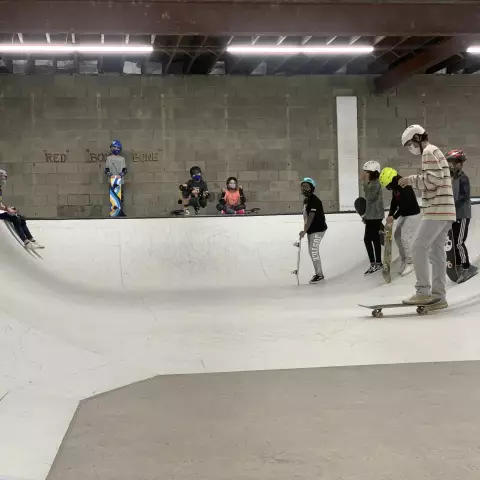After watching online videos about skateboarding, many begin to rave about this sport, buy a board, but cannot repeat even a small fraction of the video. In order for a dream to become a reality, it is necessary to train for a long time and a lot, while it is necessary to start with the simplest tricks, gradually complicating them more and more.
Instructions
Step 1
In order to learn to ride a skateboard, you need to get used to it, stand up so that it is comfortable. You can do this at home or on the street - just put the skate on and stand on it, feel the board, try to rearrange your legs, balance, in a word, control the board in place. Before starting to move, find out which leg is your support. The simplest thing is to just kick the ball, the supporting leg will be the one that will be more comfortable to do this, i.e. on the skateboard, she will stand in the back. Most people have a supporting leg, it is also a snap leg - the right one.
Step 2
It is better to start skating in places where there are no cars and people, for example, in parks. At the same time, for the first time, it is better to choose a flat surface, without slopes and rises. Place your foot over the front wheels, and with the second, support, kick off the surface, as soon as the board moves, place your foot on the skateboard. Try to ride the board while standing completely on it while maintaining your balance. To prevent the skate from accelerating, push your supporting leg back and increase the pressure on it.
Step 3
There are several ways to stop in skateboarding. The easiest way is to remove your support leg from the skate and brake it along the ground. However, this method is only suitable for a flat surface.
Another way is to brake with your heel. Press the heel of your skating foot onto the board so that the front of the skate rises into the air. Increase the pressure on the heel, but do not forget about the front foot, it should still remain on the board.
Step 4
Turns on the board are sharp and smooth. It is better to start learning to turn with smooth turns, for this you need to extend your leg and turn the body in the direction you need. Remember, the harder you press on the heel, the sharper the turn angle will be. The best way to train such turns is to roll around an object.
Sharp turns are carried out by balancing on the rear wheels. Place your supporting foot on the tail of the skateboard and your front foot on the nose, while maintaining its position relative to the board. Transfer most of your body weight to your supporting leg while swinging the nose of the board in different directions. Turn around on the skateboard so that the legs are reversed. Learn to do this in place, shifting your body weight as you turn. When driving, turns are performed first in one direction, then in the other.
Step 5
Once you've mastered straight skateboarding. You can move on to learning tricks. The first of these should be the Ollie trick. Despite its simplicity, it is the basis for most of the tricks performed by skaters. Ollie is bouncing on a skateboard.
The position of the legs for all riders when performing Ollie is different, someone puts their legs wider, someone, on the contrary, is closer to each other, it is important that you feel comfortable. So, put the leading, front, foot in the middle of the deck or slide to the front bolts, and the snap foot to the tail. Accelerate. At the same time, the knees should be slightly bent. With your supporting foot, press sharply on the tail of the board, it will sound like a click, and immediately start pushing off the ground along with the board. It turns out a kind of jump on one leg. In this case, the leading leg moves up and forward along the skin. It turns out that the foot of the front leg, as it were, clings to the skin and pulls the entire board up and the latter rises into the air. Skaters call this movement "drawing." It is better to do this with the foot of the leading leg bent inward. When landing, the feet of both feet are best placed on or near the bolts, then the likelihood of injury yourself or breaking the board will significantly decrease. Also, do not forget about the center of gravity - during the flight, it is not advisable to either lean back or fall forward. Despite its simplicity from the first try, Ollie has probably not yet worked for any rider. The key to Ollie's high performance is long training.






